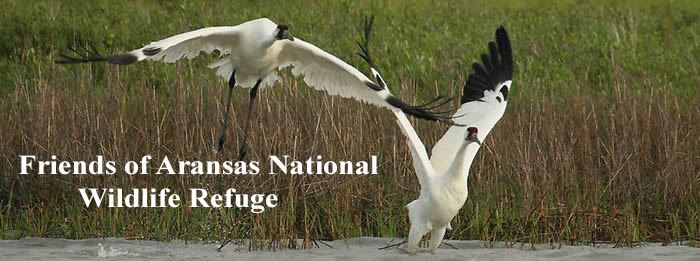Wintering Whooping Crane Update, March 29, 2016
Wade Harrell, U.S. Whooping Crane Recovery Coordinator
Whooping crane spring migration has begun. It has been a tremendous winter season here at Aransas NWR, but the whooping cranes seem to be ready to get back up to Wood Buffalo National Park for another breeding season.
As of this morning, of 11 birds that have active satellite transmitters, 4 have departed Aransas NWR. The 4 marked cranes are spread out from Central Texas to South Dakota. Reports received over the last few weeks from states in the migration corridor indicate 31 whooping cranes have been spotted in migration from Kansas to South Dakota. The number of whooping cranes at Aransas will quickly dwindle over the next few weeks. Spring migration is typically shorter in duration than fall migration, usually taking about 30 days.
We have posted the 2014-2015 Whooping Crane Recovery Report on our website. As soon as results from the Annual Whooping Crane Winter Abundance Survey are complete, we will post a summary on the Aransas NWR website as well.
Whooping Cranes on the Refuge
Cranes were recently seen from the observation tower on the Refuge, but it’s difficult to say how much longer they will remain. There are many other interesting wildlife species to view at the Refuge now, though, so don’t hesitate to come out and enjoy other spring wildlife watching opportunities! Our Rail Trail bridge has recently been rebuilt, and it’s been a great spot to see young alligators, bullfrogs, and colorful fish.
Texas Whooper Watch
Please report any whooping cranes you observe migrating in Texas to Texas Whooper Watch. The old saying “a photo is worth a thousand words” applies to reporting whooping cranes as well. Just be careful not to disturb or get too close the birds!
While we didn’t have nearly as many whooping cranes use inland sites this winter, Texas Whooper Watch still provided us vital information during migration. Please continue to keep watch for whooping cranes and send in your reports.
Habitat management on the Refuge
Refuge staff burned 8 units this winter, totaling 5,822 acres. This year's season was difficult in terms of meeting objectives due to smoke management and weather windows. The season started off very wet from the effects of the above average rainfall in calendar year 2015 and the anticipation of a predicted wet winter from El Nino conditions. The wet conditions persisted into early January and then rapidly changed. The predicted El Nino event never materialized for January/February and many dry fronts came through South Texas resulting in conditions outside of prescription with relative humidities in the teens.
Units burned in January and February continue to exhibit excellent wildlife response. Crane units 6 and 7, along with the burns on the south end of Matagorda Island, showed prolonged whooping crane use with over 40 individuals counted on single burn units at times.
Precipitation/Salinity:
The Refuge received 5.53 inches of rain from January-March 28. Freshwater levels and food resources remained high throughout this winter season. Salinity levels in San Antonio Bay are currently around 10-12 parts per thousand.
